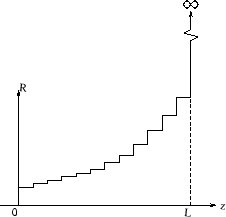Back to Kemp Acoustics Home




Next: Projection across a discontinuity
Up: Multimodal propagation in acoustic
Previous: Solutions for rectangular cross-section
Contents
Method for calculation of input impedance
We have presented the equations for the pressure and
axial velocity in a duct in terms of the unknowns  and
and  .
Now we define the left hand side (negative
.
Now we define the left hand side (negative  side) of a
waveguide of arbitrary cross-section as the input end and the right hand side
(positive
side) of a
waveguide of arbitrary cross-section as the input end and the right hand side
(positive  side) as the output end. The waveguide is then approximated by a
series of uniform sections as shown in figure 2.8 (cylinders in
circular geometry and rectangular sections in rectangular geometry).
side) as the output end. The waveguide is then approximated by a
series of uniform sections as shown in figure 2.8 (cylinders in
circular geometry and rectangular sections in rectangular geometry).
Figure 2.8:
Horn approximated by a series of cylinders
 |
In plane wave acoustics the impedance is defined as the ratio of the acoustic
pressure and volume velocity. For the multimodal case we define the acoustic
impedance matrix,  , as follows:
, as follows:
 |
(2.95) |
so that
 |
(2.96) |
and therefore  is the factor of contribution to the pressure
amplitude of the
is the factor of contribution to the pressure
amplitude of the  th mode due to the volume velocity amplitude of the
th mode due to the volume velocity amplitude of the  th
mode. The vectors and matrices are infinite but must be truncated before
numerical implementation.
th
mode. The vectors and matrices are infinite but must be truncated before
numerical implementation.
Subsections
Back to Kemp Acoustics Home




Next: Projection across a discontinuity
Up: Multimodal propagation in acoustic
Previous: Solutions for rectangular cross-section
Contents
Jonathan Kemp
2003-03-24

![]() , as follows:
, as follows:
